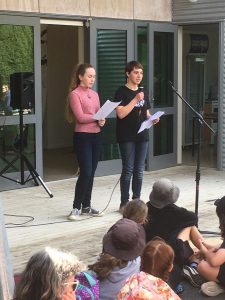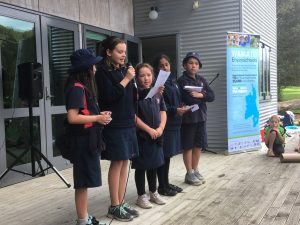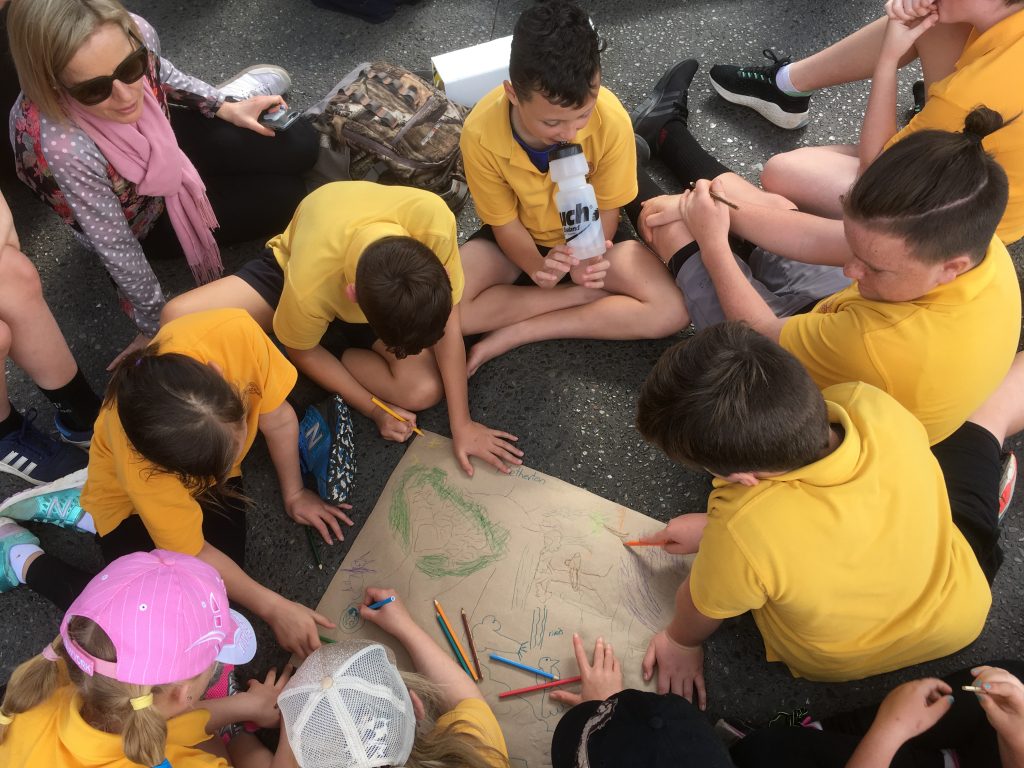In September, over 100 students from Enviroschools in Upper Eastern Waikato came together with local biodiversity experts for an inspiring day immersed in the ‘Nature Needs Us’ themed Conservation Week at the Kauaeranga DOC visitors centre.
Young people from 12 Enviroschools in Thames-Coromandel, Hauraki and Matamata Piako districts joined in to share intergenerational learning, knowledge, and experience with each other.

Lillian and Helena from Thames High School speak about climate change.
The first half of the day saw students in mixed school groups rotating around a range of presentations and interactive workshops given by biodiversity experts from the local community. Experts in gecko encounters, stream life, predator control, shore birds, kauri, kiwi and more were present to join in with the students for a day of collective discovery.
In the afternoon, Thames High School Enviro-group leaders Helena Mayer and Lillian Balfour gave an interactive presentation to all students, teachers and community experts.
The Enviro-group leaders shared their knowledge about Climate Change in ‘kids speak’ (communicating their ideas in a way that the whole audience could understand) and then facilitated groups to mind map their vision for the future of the earth on big sheets of paper.
Group participants then brainstormed ideas around what they could do right now to achieve this vision.
Helena and Lillian then ended their presentation with an invitation for all schools to join them for their planned ‘School Strike and Action Day for Climate’’ the following week.
Thames High School Enviro-group planned a full day of events for the School Strike, such as a community planting in the morning which lead to a street march and a ‘Climate Concert’, where there would be another opportunity for kids to share knowledge, and mentor more students and the whole community.

Waihi Central share their vision for the future.
Following the Thames High presentation, all the other schools at the Kauaeranga event shared ‘soap box’ style learning and action from their school.
Some had prepared story boards to speak to, while some stood up and spoke from their heart about what was important to them about their schools’ enviro/community initiatives.
At times their actions supported what students had been learning about in the morning sessions; for example, Opoutere School shared about their project to bring the native birds back into their school.

Kaihere students share their practices.
They explained how after researching and planting bird attracting natives, they are now making and setting tracking tunnels in the area to see what predators are about, to inform what methods they need to use to deter these.
This was a great follow up to Moehou Environment group’s session for making tracking tunnels. Thames Coast Kiwi Care’s session on predators and trapping then gave students an example of a school putting these ideas into action.
The feedback from the day expressed how inspired students felt by the practices and actions shown that day, and that they were excited to take ideas back to share with their own schools.
Tou rourou, toku rourou, ka ora te Iwi
With your contribution, and my contribution, we will thrive
The Enviroschools kaupapa teaches that every person can bring unique perspectives and gifts to learning, and it is by combining them that sustainable communities will be created. The Nature Needs Us hui in Kauaeranga has been a perfect example of empowered students and sustainable communities walking hand in hand.

Netherton students work together to create a vision for the future.
For schools, Conservation Week provides an opportunity to explore the living world strand of the science curriculum, the concepts of place and environment in the social sciences curriculum, the future focus issue of sustainability, and values such as community and participation, and care for the environment.
You can find teaching resources to support your students to engage with Conservation Week at Te Kete Ipurangi